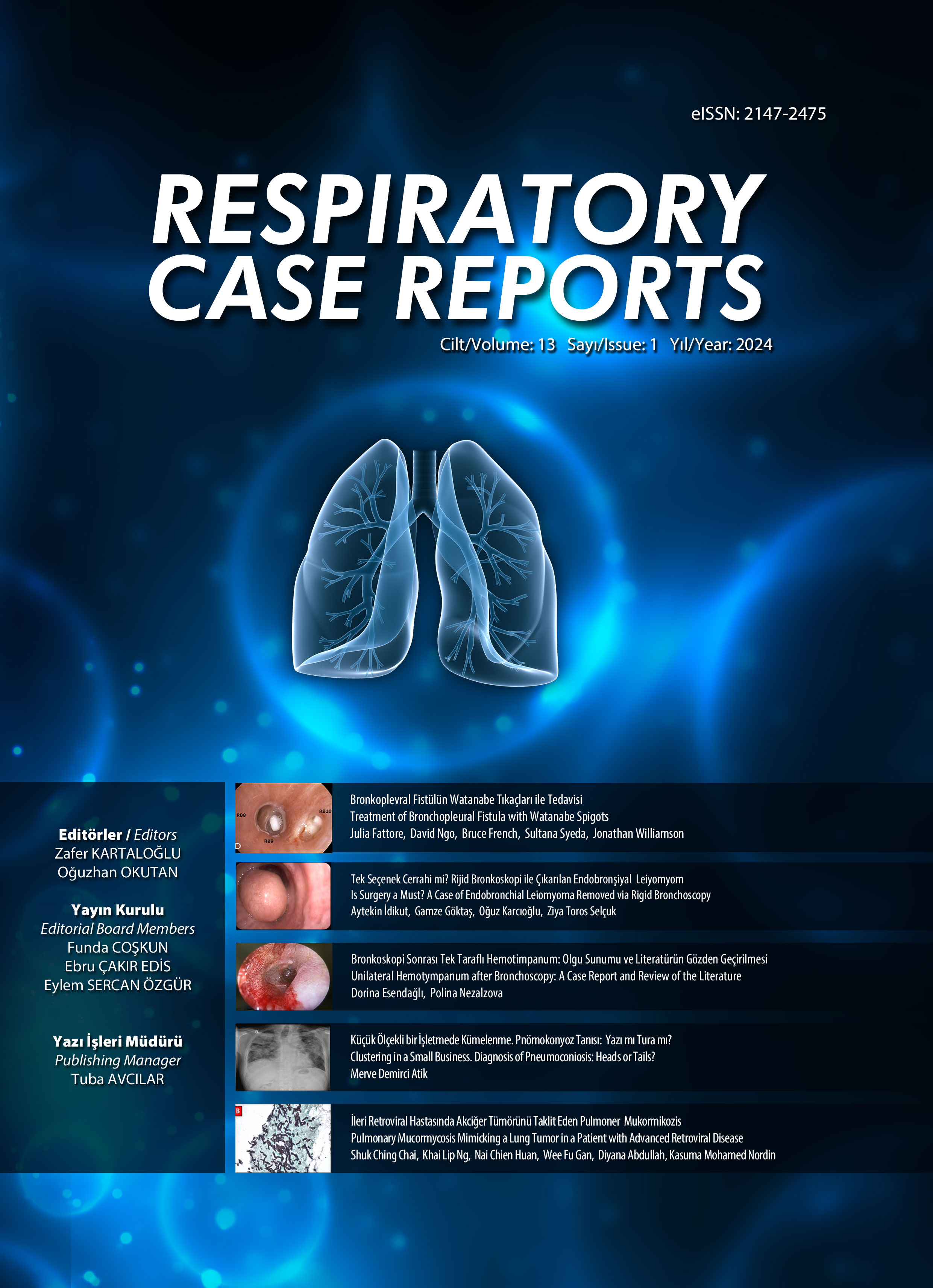
İnterstistiyel Akciğer Hastalığı ile Seyreden Hemanjiyolenfanjioma: Nadir Bir Olgu
Gülçehre Oğuztürk1, Selin Onay Mahmuti2, Ece Yasemin Demirkol2, Neslihan Fener3, Ekrem Cengiz Seyhan1, Erdoğan Çetınkaya1, Muzaffer Metin21SBÜ Yedikule Göğüs Hastalıkları ve Göğüs Cerrahisi Eğitim ve Araştırma Hastanesi, Göğüs Hastalıkları Kliniği, İstanbul2SBÜ Yedikule Göğüs Hastalıkları ve Göğüs Cerrahisi Eğitim ve Araştırma Hastanesi, Göğüs Cerrahisi Kliniği, İstanbul
3SBÜ Yedikule Göğüs Hastalıkları ve Göğüs Cerrahisi Eğitim ve Araştırma Hastanesi, Patoloji Kliniği, İstanbul
Vasküler anomaliler, embriyonik yaşamda oluşan, lenfatik ve kapiller sistemleri etkileyen patolojilerdir ve histolojik özelliklerine göre vasküler tümörler veya vasküler malformasyonlar olarak sınıflandırılırlar. Nadir görülürler ve daha çok yaşamın ilk yıllarında saptanırlar. Hemanjiyolenfanjiyomlar da lenfatik ve kapiller sistem elemanları içeren, benign bir vasküler tümördür. İnsidansı yenidoğanlarda 1/12.000 olarak bildirilmiştir. Bugüne dek bildirilen olgular baş bölgesi (ağız boşluğu, orbita vs), boyun ve mediasten bölgelerindedir. Biz de bu makalede interstistiyel akciğer hastalığı ile seyreden ve yapılan tanısal video yardımlı akciğer bi-yopsisi (VATS) işlemi sonrasında hemanjiyolenfanjiyoma tanısı alan 17 yaşında bir erkek hastayı sunduk. Kronik bir hastalığı olmayan ve sekiz aydır olan öksürük ve nefes darlığı ile polikliniğe başvuran hastaya çekilen toraks tomografisinde interstistiyel akciğer özellikleri görülmüş olup; VATS işlemi sonra-sında hastada şilotoraks gelişti. Patoloji so-nucu hemanjiyolenfanjiyom olarak sonuçlandı.
Anahtar Kelimeler: Hemanjiyolenfanjiyom, şilotoraks, interstistiyel, akciğer.Hemangiolymphangioma with Accompanying Interstitial Lung Disease: A Rare Case
Gülçehre Oğuztürk1, Selin Onay Mahmuti2, Ece Yasemin Demirkol2, Neslihan Fener3, Ekrem Cengiz Seyhan1, Erdoğan Çetınkaya1, Muzaffer Metin21Department of Chest Diseases, Health Science University, Yedikule Training and Research Hospital for Chest Diseases and Thoracic Surgery, İstanbul, Turkey2Department of Thoracic Surgery, Health Science Uni-versity, Yedikule Training and Research Hospital for Chest Diseases and Thoracic Surgery, İstanbul, Turkey
3Department of Pathology, Health Science University, Yedikule Training and Research Hospital for Chest Diseases and Thoracic Surgery, İstanbul, Turkey
Vascular anomalies are pathologies that occur in embryonic life that affect the lymphatic and capillary systems, and can be classified as vascular tumors or vascular malformations, according to their histological features. They are rare and are mostly detected in the first years of life. Hemangio-lymphangiomas are benign vascular tumors containing lymphatic and capillary system elements with a reported incidence of 1: 12,000 in newborns. The cases reported to date have been in the head (oral cavity, orbita, etc.), neck and mediastinum regions. We presented here a case of a 17-year-old male patient who was diagnosed with hemangiolymphangioma after a videoassisted lung biopsy (VATS) with accompa-nying interstitial lung disease. The patient, who had no history of chronic disease, pre-sented to the outpatient clinic complaining of cough and shortness of breath for eight months. Interstitial lung features were ob-served in the patients thorax computer tomography. After the VATS procedure, the patient developed chylothorax, and the pathology results indicated hemangiolymphangioma.
Keywords: Hemangiolymphangioma, chylothorax, interstitial, lung.Olgunun Görüntü Kesitleri
Makale Dili: İngilizce











